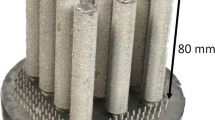Abstract
This paper aims to present the metallurgical and mechanical characterization of cryogenically treated tungsten carbide (WC–Co) in terms of α-, β-, γ-, and η-phase particles and wear behavior, respectively. The specimens of commercially available uncoated WC–Co in the form of round turning inserts were procured and subjected to cryogenic treatment at two levels −110°C (shallow treatment) and −196°C (deep treatment) of temperature. The microstructures obtained after cryogenic treatments have been characterized with a prominence to comprehend the influence of cryogenic treatment on the nature, size, and distribution of α-, β-, γ-, and η-phase particles as compared to untreated specimen. The mechanical properties such as hardness and wear rate of the specimens have also been compared by performing Rockwell A hardness test and pin-on-disk wear test, respectively. Microstructures, hardness, wear rate, and analysis of worn surface divulge the underlying metallurgical mechanism responsible in improving mechanical properties of the WC–Co.
Similar content being viewed by others
References
Barron RF (1996) Low temperature properties of engineering materials. In: Cryogenic systems, New York: McGraw-Hill, pp 15–23
Albert M (1992) Cutting tools in the deep freeze. Mod Mach Shop 64(8):55–61
Sweeney TP (1986) Deep cryogenics: the great cold debate. Heat Treat 18(2):28–32
Kosmowski M (1981) The promise of cryogenics. Carbide Tool J 26–30
Collins DN (1996) Deep cryogenic treatment of tool steels, a review. Heat Treat Met 2:40–42
Gill SS, Singh J (2010) Effect of deep cryogenic treatment on machinability of titanium alloy (Ti-6246) in electric discharge drilling. Mater Manuf Process 25(6):378–385
Gill SS, Singh J, Singh R, Singh H. Metallurgical principles of cryogenically treated tool steels—a review on the current state of science, Int J Adv Manuf Technol 10.1007/s00170-010-2935-5
Reddy TVS, Ajaykumar BS, Reddy MV, Venkataram R (2007) Improvement of tool life of cryogenically treated P-30 tools. In: Proceedings of International Conference on Advanced Materials and Composites (ICAMC-2007) at National Institute for Interdisciplinary Science and Technology, CSIR, Trivandrum, India, pp 457–460
Yong AYL, Seah KHW, Rahman M (2007) Performance of cryogenically treated tungsten carbide tools in milling operations. Int J Adv Manuf Technol 32:638–643
Yong AYL, Seah KHW, Rahman M (2006) Performance evaluation of cryogenically treated tungsten carbide tools in turning. Int J Mach Tools Manuf 46:2051–2056
Seah KHW, Rahman M, Yong KH (2003) Performance evaluation of cryogenically treated tungsten carbide cutting tool inserts. Proc IME B J Eng Manufact 217:29–43
Bonilla C, Meara RO, Perry L (2007) Evaluation of the comparative performance of cryogenically treated cutting inserts as a capstone design project. ASEE Annual Conference and Exposition, Conference Proceedings, pp 9
Quek TW (2004) Machining of steel using cryogenically treated cutting tool inserts. PhD thesis, National University of Singapore, Singapore
Kao M (1984) The effect of cryogenic treatment on sintered tungsten carbide. Master thesis, Arizona State University, USA
Bryson WE (1999) Cryogenics. Hanser Gardner Publications, Cincinnati, pp 81–107
Stewart HA (2004) Cryogenic treatment of tungsten carbide reduces tool wear when machining medium density fiberboard. For Prod J 54(2):53–56
Gallagher AH, Agosti CD, Roth JT (2005) Effect of cryogenic treatments on tungsten carbide tool life: microstructural analysis. Trans N Am Manuf Res Inst SME 33:153–160
Gill SS, Singh R, Singh H, Singh J (2009) Wear behaviour of cryogenically treated tungsten carbide inserts under dry and wet turning conditions. Int J Mach Tools Manuf 49:256–260
Gill SS, Singh J, Singh H, Singh R (2011) Investigation on wear behaviour of cryogenically treated TiAlN coated tungsten carbide inserts in turning. Int J Mach Tools Manuf 51:25–33
Gill SS, Singh H, Singh R, Singh J (2010) Cry processing of cutting tool materials—a review. Int J Adv Manuf Tech 48:175–192
Kim S, Han SH, Park JK, Kim HE (2004) Variation of WC grain shape with carbon content in the WC-Co alloys during liquid-phase sintering. Scr Mater 48:635
Christensen M (2004) Strength and stability of interfaces in cemented carbides, Thesis No. 2133 (ISBN 91-7291-451-3). Chalmers University of Technology, Gothemburg
Exner HE (1981) Qualitative and quantitative interpretation of microstructures in cemented carbides. In: Viswanadham RK, Rowcliffe DJ, Gurland J (eds), Proceedings of Int Conf Sci Hard Mater, New York: Plenum Press
Bolognini S (2000) Propriétés mécaniques à haute température de cermets Ti(C,N)-WC-Mo-Co à gradient de composition pour outils de coupe, Thesis EPFL N° 2161
Engqvist H, Högberg H, Botton GA, Axén N, Ederyd S, Hogmark S (2000) Tribofilm formation on cemented carbides in dry sliding conformal contact. Wear 239:219–228
Katharina B (2004) High temperature deformation mechanisms of cemented carbides and cermets, Thesis EPFL No. 3095. Chalmers University of Technology, Gothemburg
Author information
Authors and Affiliations
Corresponding author
Rights and permissions
About this article
Cite this article
Gill, S.S., Singh, J., Singh, H. et al. Metallurgical and mechanical characteristics of cryogenically treated tungsten carbide (WC–Co). Int J Adv Manuf Technol 58, 119–131 (2012). https://doi.org/10.1007/s00170-011-3369-4
Received:
Accepted:
Published:
Issue Date:
DOI: https://doi.org/10.1007/s00170-011-3369-4




